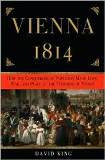Wednesday, February 18, 2009
New Tolkien Book
Some favorite Norse myths - Sigurd the Gram-wielding, dragon-slaying Volsung and the Fall of the Niflungs - will be retold by J.R.R. Tolkien in the forthcoming The Legend of Sigurd and Gudrun (May, 2009). Tolkien wrote the previously unpublished manuscript in Oxford in the 1920s and 1930s. His son, Christopher Tolkien, will provide commentary in the edition by Houghton Mifflin Harcourt (HarperCollinsUK for the British). Christopher has a good edition, by the way, of the Hervararsaga, the Norse saga that Olof Rudbeck drew a map for in Verelius' 1672 edition - the very map that would eventually lead him on his life-long quest for Atlantis.
Saturday, February 14, 2009
The Party that Changed the World
Wouldn't it be nice to have a clock that would slow down in times of pleasure and speed up in times of trial? That was once a wish of Austrian Emperor Francis I, who could certainly have used such a device in the autumn of 1814 when he opened his palace to a veritable royal mob who would never seem to agree, or leave. The occasion was the Congress of Vienna, a glittering peace conference at the end of the French Revolutionary and Napoleonic Wars.
For a time, Vienna became the capital of Europe, the site of a massive victory celebration, and home to the most glamorous gathering since the fall of the Roman Empire. Never before have more kings, queens, and princes lived in the same place for such a long period of time.
Catering to the whims of these houseguests would sometimes be exasperating. Vienna wits soon poked fun at the early impressions made by the crowned heads who would so readily accept Emperor Francis's generosity:
The Emperor of Russia: He makes love for everyone.
The King of Prussia: He thinks for everyone.
The King of Denmark: He speaks for everyone.
The King of Bavaria: He eats for everyone.
The King of Württemberg: He eats for everyone.
The Emperor of Austria: He pays for everyone.
In the end, after nine months of negotiations, celebrations, and intrigues, the Congress of Vienna would finally wrap up, drastically reconfiguring the balance of power and ushering in a modern age.
For more, see my book Vienna 1814: How the Conquerors of Napoleon Made Love, War, and Peace at the Congress of Vienna. I originally posted this on Wonders and Marvels, a fascinating new blog by Holly A. Tucker, Professor at the Center for Medicine, Health, and Society at Vanderbilt University.
For a time, Vienna became the capital of Europe, the site of a massive victory celebration, and home to the most glamorous gathering since the fall of the Roman Empire. Never before have more kings, queens, and princes lived in the same place for such a long period of time.
Catering to the whims of these houseguests would sometimes be exasperating. Vienna wits soon poked fun at the early impressions made by the crowned heads who would so readily accept Emperor Francis's generosity:
The Emperor of Russia: He makes love for everyone.
The King of Prussia: He thinks for everyone.
The King of Denmark: He speaks for everyone.
The King of Bavaria: He eats for everyone.
The King of Württemberg: He eats for everyone.
The Emperor of Austria: He pays for everyone.
In the end, after nine months of negotiations, celebrations, and intrigues, the Congress of Vienna would finally wrap up, drastically reconfiguring the balance of power and ushering in a modern age.
For more, see my book Vienna 1814: How the Conquerors of Napoleon Made Love, War, and Peace at the Congress of Vienna. I originally posted this on Wonders and Marvels, a fascinating new blog by Holly A. Tucker, Professor at the Center for Medicine, Health, and Society at Vanderbilt University.
Monday, February 9, 2009
The White House Album Collection
The Sex Pistols' Never Mind the Bollocks, Here's the Sex Pistols, Ramones' Rocket to Russia, Captain Beefheart's Trout Mask Replica, Kinks' Arthur, and Bruce Springsteen's Born to Run are some of the 2,200 albums that once stood in a hallway of the third floor of the White House. Under Ronald Reagan, however, the lps were packed off to the basement, where they apparently remain. David Browne, author of the well-received Sonic Youth biography (Goodbye 20th Century) writes more on the collection in the latest issue of Rolling Stone.
Subscribe to:
Comments (Atom)

